2007 ISUZU KB P190 Wiring
[x] Cancel search: WiringPage 5686 of 6020
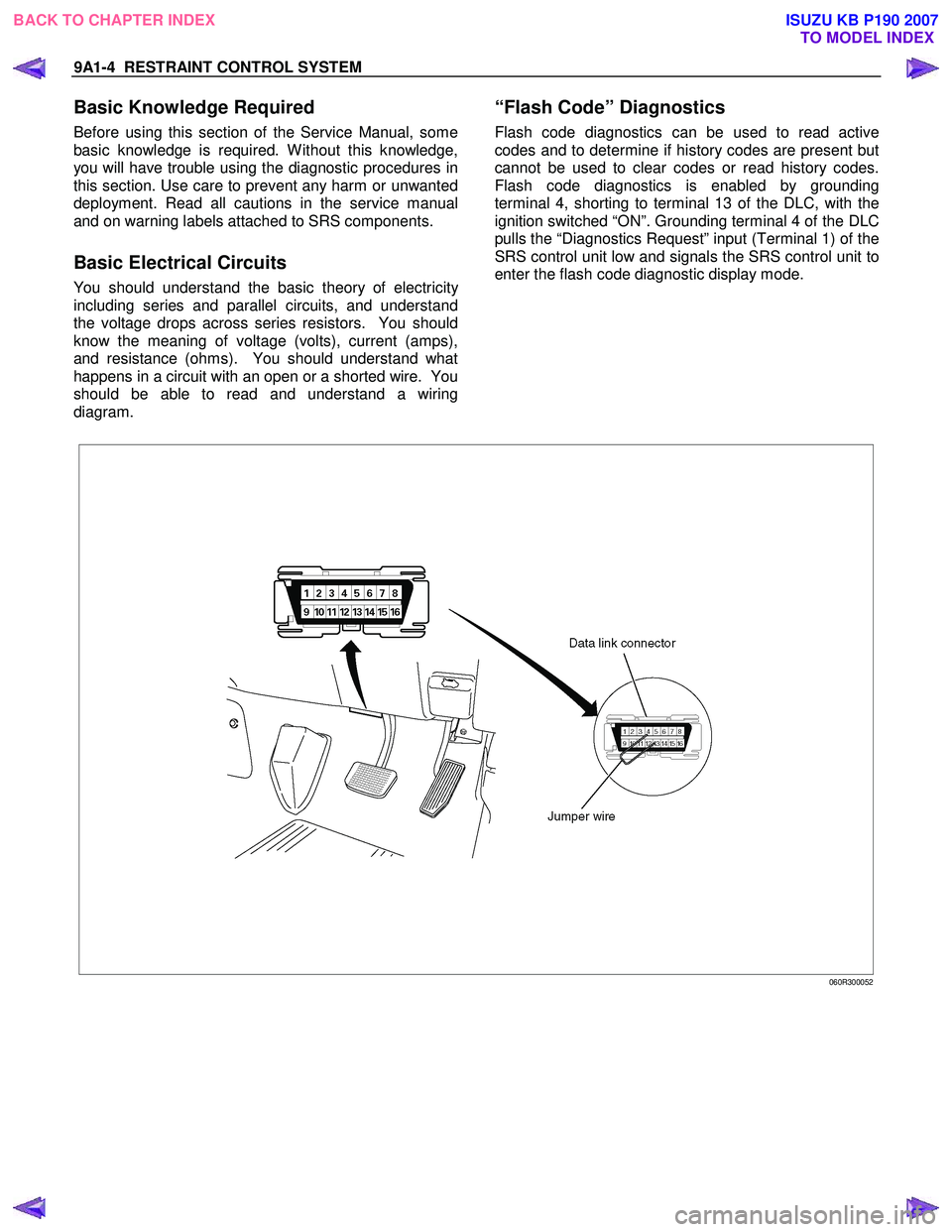
9A1-4 RESTRAINT CONTROL SYSTEM
Basic Knowledge Required
Before using this section of the Service Manual, some
basic knowledge is required. W ithout this knowledge,
you will have trouble using the diagnostic procedures in
this section. Use care to prevent any harm or unwanted
deployment. Read all cautions in the service manual
and on warning labels attached to SRS components.
Basic Electrical Circuits
You should understand the basic theory of electricity
including series and parallel circuits, and understand
the voltage drops across series resistors. You should
know the meaning of voltage (volts), current (amps),
and resistance (ohms). You should understand what
happens in a circuit with an open or a shorted wire. You
should be able to read and understand a wiring
diagram.
“Flash Code” Diagnostics
Flash code diagnostics can be used to read active
codes and to determine if history codes are present but
cannot be used to clear codes or read history codes.
Flash code diagnostics is enabled by grounding
terminal 4, shorting to terminal 13 of the DLC, with the
ignition switched “ON”. Grounding terminal 4 of the DLC
pulls the “Diagnostics Request” input (Terminal 1) of the
SRS control unit low and signals the SRS control unit to
enter the flash code diagnostic display mode.
060R300052
BACK TO CHAPTER INDEX TO MODEL INDEX
ISUZU KB P190 2007
Page 5696 of 6020

9A1-14 RESTRAINT CONTROL SYSTEM
Chart C “SRS” Warning Lamp Does Not Come “ON” Steady
RTW 79ALF000301
Circuit Description
W hen the ignition switch is first turned “ON”, “Ignition 1”
voltage is applied from the “METER” fuse to the “SRS”
warning lamp which is connected to the “SRS W arning
Lamp”, terminal “4”. The “SRS” fuse applies system
voltage to the “Ignition 1” inputs, terminals “35”. The
SRS control unit responds by flashing the “SRS”
warning lamp seven times. If “Ignition 1” is more than
16 volts, the “SRS” warning lamp will still be “OFF” solid
with no DTCs set.
Chart Test Description
Number(s) below refer to step number(s) on the
diagnostic chart:
1. This test decides whether power is available to the
SRS control unit warning lamp power feed circuit.
2. This test determines whether the voltage is present
in the warning lamp circuit.
3. This test determines if the malfunction is in the
instrument cluster.
4. This test checks for open in the warning lamp
circuitry.
5. This test isolates the SRS warning lamp circuit and
checks for a short in the SRS warning lamp circuit to
B+.
8. This test checks for a short from the SRS control
unit warning lamp power feed circuit to ground.
9. This test determines whether the short to ground is
due to a short in the wiring.
BACK TO CHAPTER INDEX TO MODEL INDEX
ISUZU KB P190 2007
Page 5699 of 6020
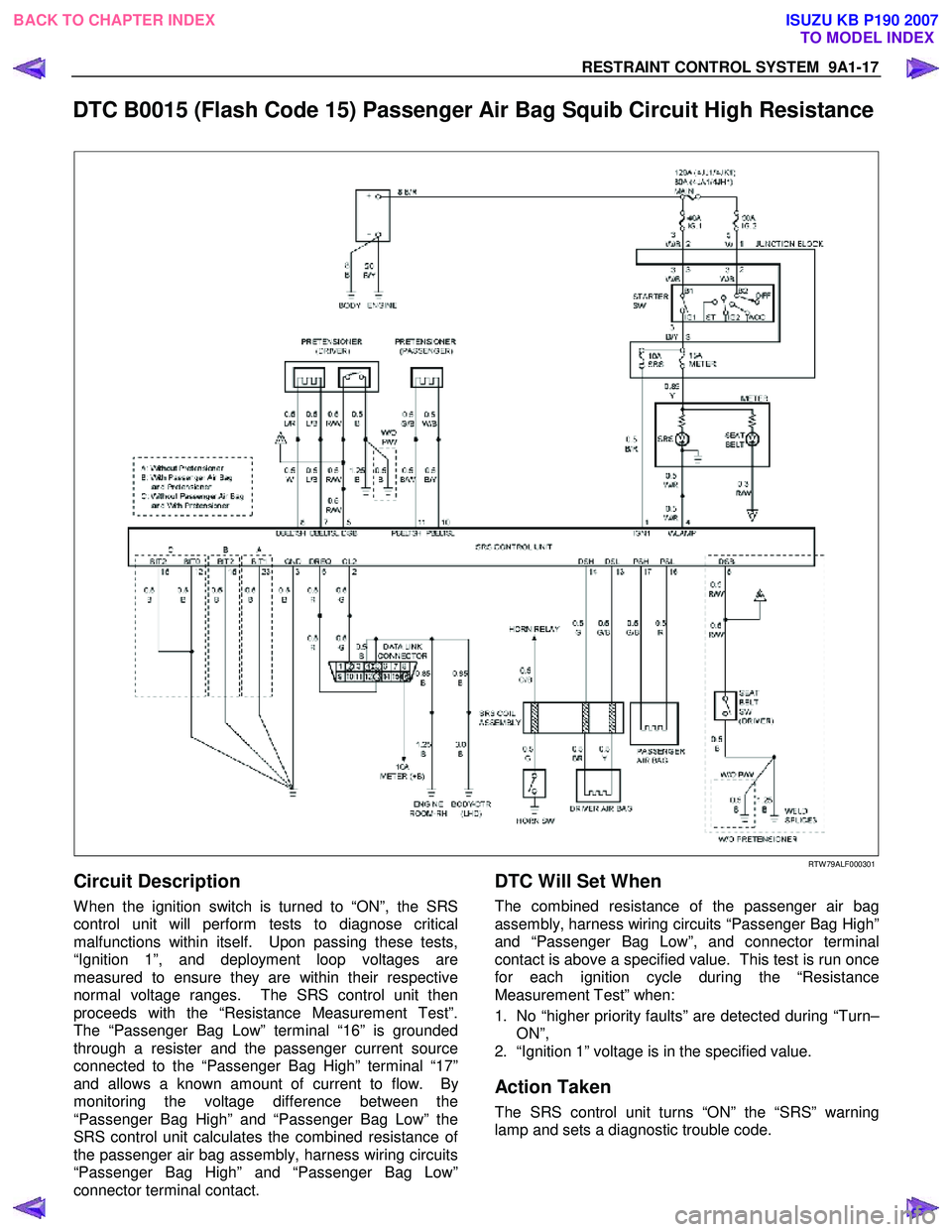
RESTRAINT CONTROL SYSTEM 9A1-17
DTC B0015 (Flash Code 15) Passenger Air Bag Squib Circuit High Resistance
RTW 79ALF000301
Circuit Description
W hen the ignition switch is turned to “ON”, the SRS
control unit will perform tests to diagnose critical
malfunctions within itself. Upon passing these tests,
“Ignition 1”, and deployment loop voltages are
measured to ensure they are within their respective
normal voltage ranges. The SRS control unit then
proceeds with the “Resistance Measurement Test”.
The “Passenger Bag Low” terminal “16” is grounded
through a resister and the passenger current source
connected to the “Passenger Bag High” terminal “17”
and allows a known amount of current to flow. B
y
monitoring the voltage difference between the
“Passenger Bag High” and “Passenger Bag Low” the
SRS control unit calculates the combined resistance o
f
the passenger air bag assembly, harness wiring circuits
“Passenger Bag High” and “Passenger Bag Low”
connector terminal contact.
DTC Will Set When
The combined resistance of the passenger air bag
assembly, harness wiring circuits “Passenger Bag High”
and “Passenger Bag Low”, and connector terminal
contact is above a specified value. This test is run once
for each ignition cycle during the “Resistance
Measurement Test” when:
1. No “higher priority faults” are detected during “Turn–
ON”,
2. “Ignition 1” voltage is in the specified value.
Action Taken
The SRS control unit turns “ON” the “SRS” warning
lamp and sets a diagnostic trouble code.
BACK TO CHAPTER INDEX TO MODEL INDEX
ISUZU KB P190 2007
Page 5700 of 6020
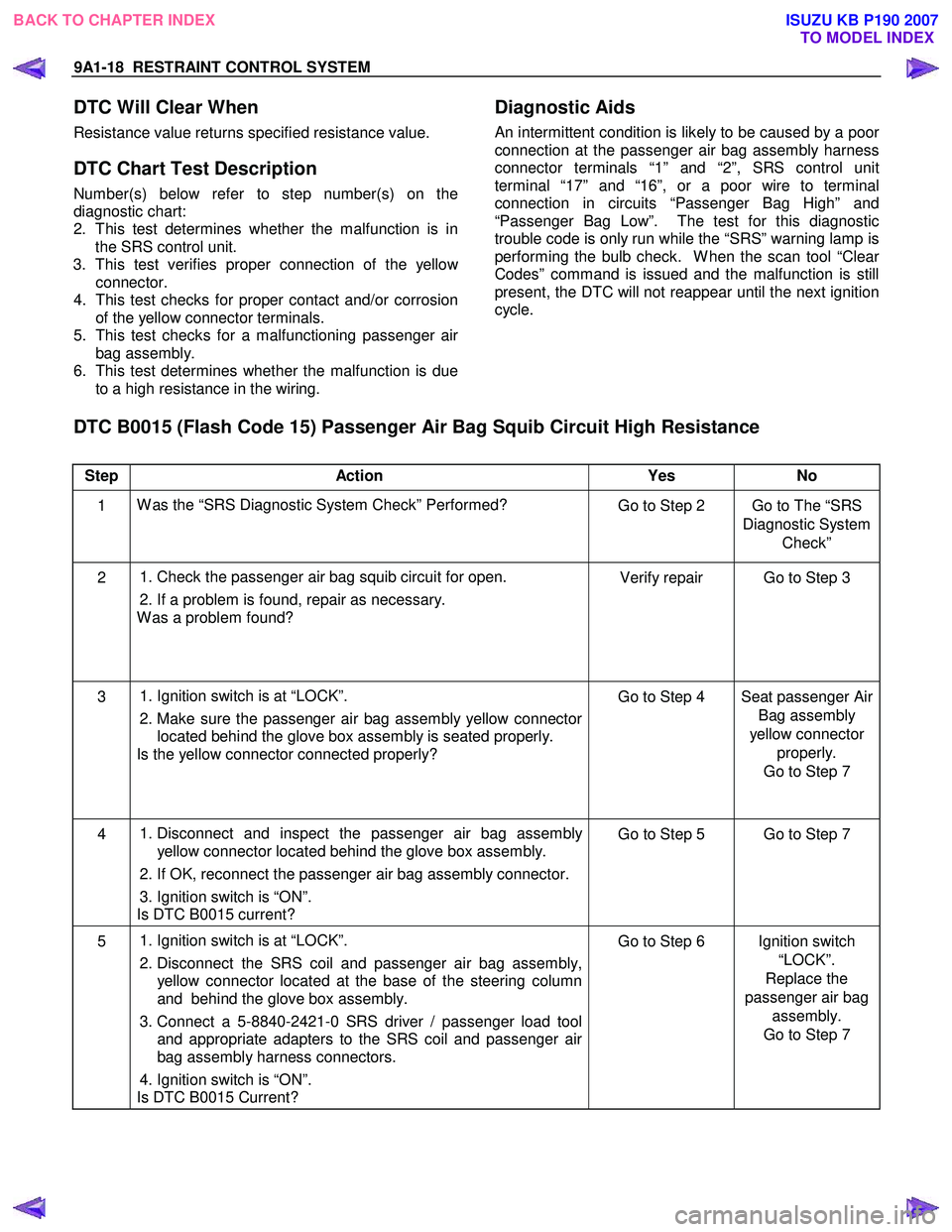
9A1-18 RESTRAINT CONTROL SYSTEM
DTC Will Clear When
Resistance value returns specified resistance value.
DTC Chart Test Description
Number(s) below refer to step number(s) on the
diagnostic chart:
2. This test determines whether the malfunction is in
the SRS control unit.
3. This test verifies proper connection of the yello
w
connector.
4. This test checks for proper contact and/or corrosion
of the yellow connector terminals.
5. This test checks for a malfunctioning passenger ai
r
bag assembly.
6. This test determines whether the malfunction is due
to a high resistance in the wiring.
Diagnostic Aids
An intermittent condition is likely to be caused by a poor
connection at the passenger air bag assembly harness
connector terminals “1” and “2”, SRS control unit
terminal “17” and “16”, or a poor wire to terminal
connection in circuits “Passenger Bag High” and
“Passenger Bag Low”. The test for this diagnostic
trouble code is only run while the “SRS” warning lamp is
performing the bulb check. W hen the scan tool “Clea
r
Codes” command is issued and the malfunction is still
present, the DTC will not reappear until the next ignition
cycle.
DTC B0015 (Flash Code 15) Passenger Air Bag Squib Circuit High Resistance
Step Action Yes No
1 W as the “SRS Diagnostic System Check” Performed?
Go to Step 2 Go to The “SRS
Diagnostic System Check”
2
1. Check the passenger air bag squib circuit for open.
2. If a problem is found, repair as necessary.
W as a problem found? Verify repair Go to Step 3
3
1. Ignition switch is at “LOCK”.
2. Make sure the passenger air bag assembly yellow connector
located behind the glove box assembly is seated properly.
Is the yellow connector connected properly? Go to Step 4 Seat passenger Air
Bag assembly
yellow connector properly.
Go to Step 7
4
1. Disconnect and inspect the passenger air bag assembly
yellow connector located behind the glove box assembly.
2. If OK, reconnect the passenger air bag assembly connector.
3. Ignition switch is “ON”.
Is DTC B0015 current? Go to Step 5 Go to Step 7
5
1. Ignition switch is at “LOCK”.
2. Disconnect the SRS coil and passenger air bag assembly,
yellow connector located at the base of the steering column
and behind the glove box assembly.
3. Connect a 5-8840-2421-0 SRS driver / passenger load tool
and appropriate adapters to the SRS coil and passenger air
bag assembly harness connectors.
4. Ignition switch is “ON”.
Is DTC B0015 Current? Go to Step 6 Ignition switch
“LOCK”.
Replace the
passenger air bag assembly.
Go to Step 7
BACK TO CHAPTER INDEX TO MODEL INDEX
ISUZU KB P190 2007
Page 5702 of 6020
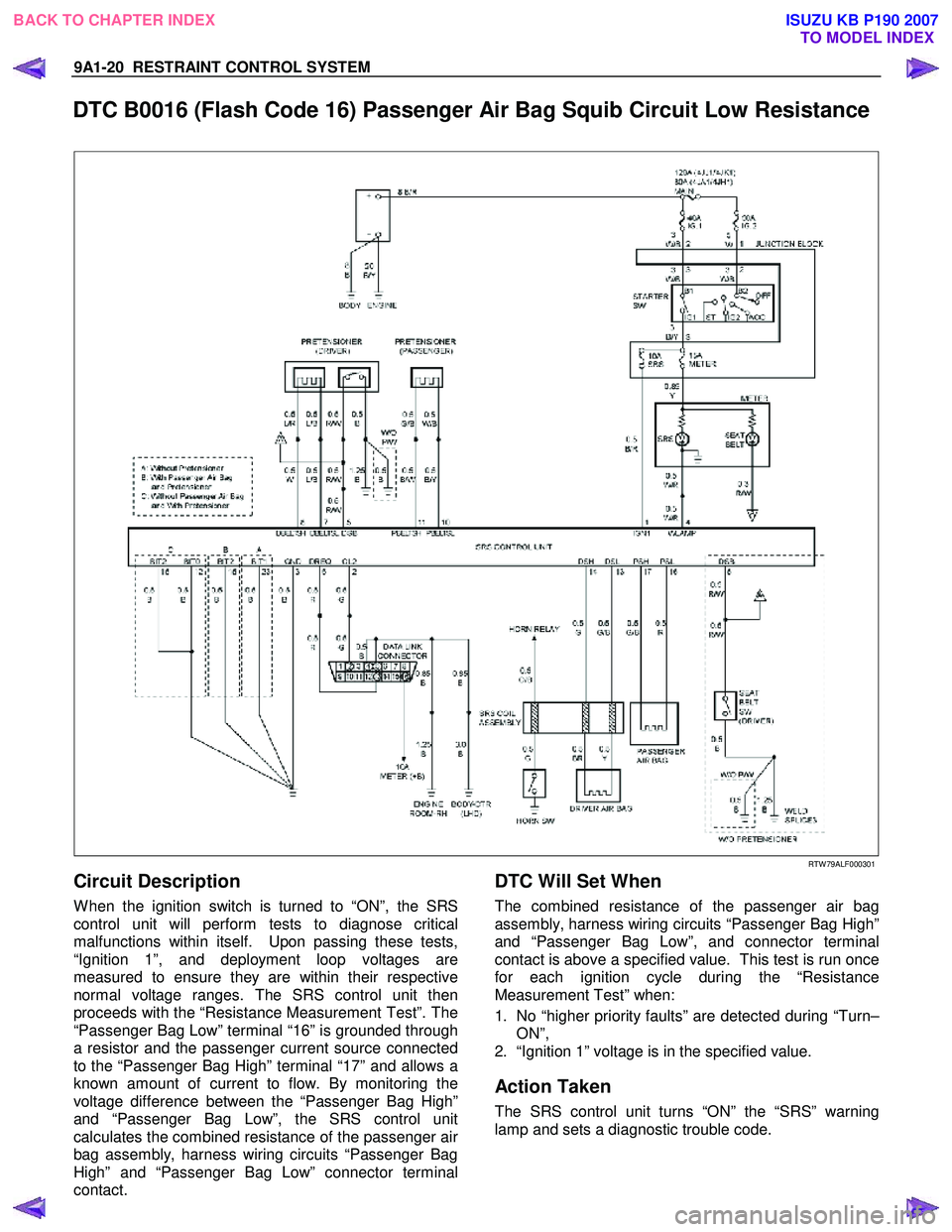
9A1-20 RESTRAINT CONTROL SYSTEM
DTC B0016 (Flash Code 16) Passenger Air Bag Squib Circuit Low Resistance
RTW 79ALF000301
Circuit Description
W hen the ignition switch is turned to “ON”, the SRS
control unit will perform tests to diagnose critical
malfunctions within itself. Upon passing these tests,
“Ignition 1”, and deployment loop voltages are
measured to ensure they are within their respective
normal voltage ranges. The SRS control unit then
proceeds with the “Resistance Measurement Test”. The
“Passenger Bag Low” terminal “16” is grounded through
a resistor and the passenger current source connected
to the “Passenger Bag High” terminal “17” and allows a
known amount of current to flow. By monitoring the
voltage difference between the “Passenger Bag High”
and “Passenger Bag Low”, the SRS control unit
calculates the combined resistance of the passenger ai
r
bag assembly, harness wiring circuits “Passenger Bag
High” and “Passenger Bag Low” connector terminal
contact.
DTC Will Set When
The combined resistance of the passenger air bag
assembly, harness wiring circuits “Passenger Bag High”
and “Passenger Bag Low”, and connector terminal
contact is above a specified value. This test is run once
for each ignition cycle during the “Resistance
Measurement Test” when:
1. No “higher priority faults” are detected during “Turn– ON”,
2. “Ignition 1” voltage is in the specified value.
Action Taken
The SRS control unit turns “ON” the “SRS” warning
lamp and sets a diagnostic trouble code.
BACK TO CHAPTER INDEX TO MODEL INDEX
ISUZU KB P190 2007
Page 5703 of 6020
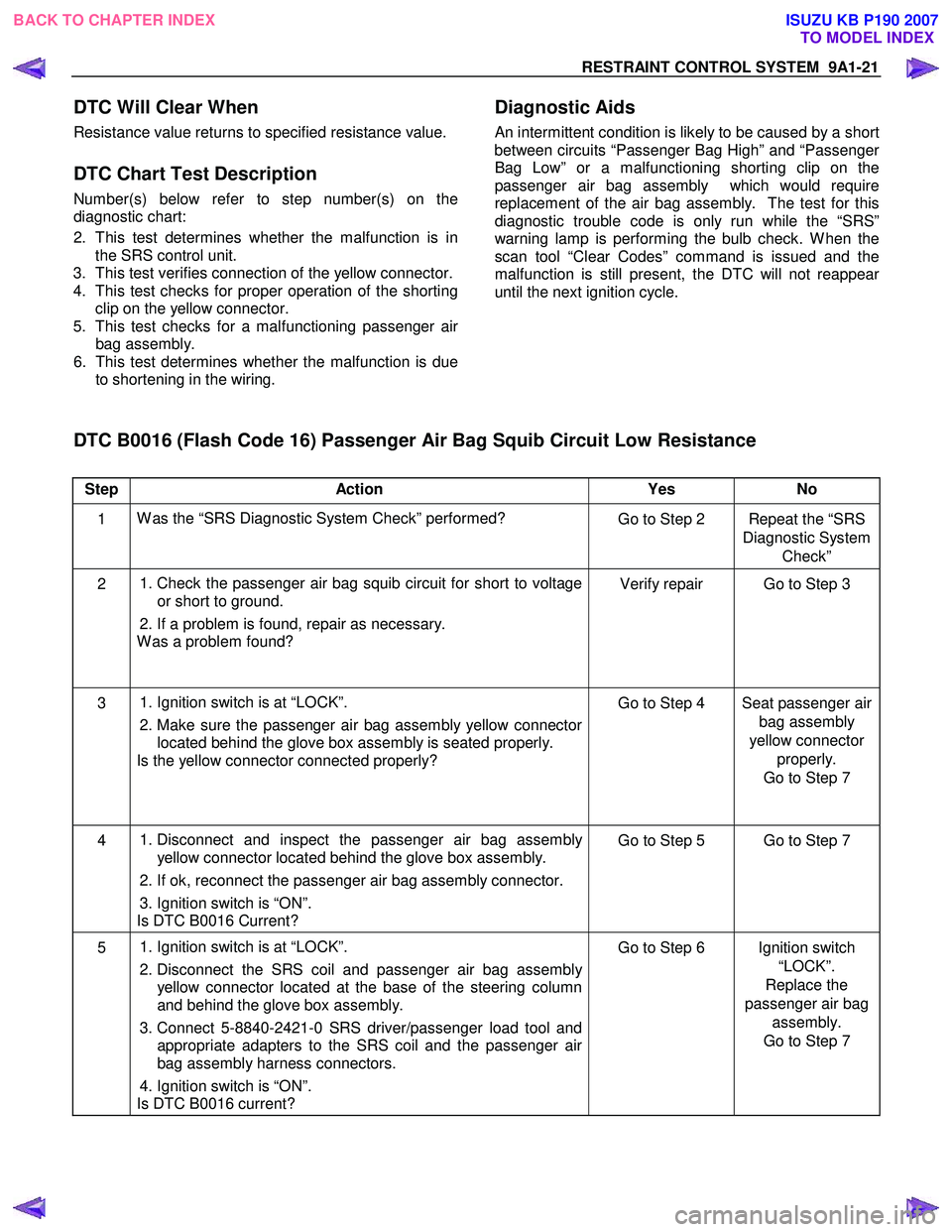
RESTRAINT CONTROL SYSTEM 9A1-21
DTC Will Clear When
Resistance value returns to specified resistance value.
DTC Chart Test Description
Number(s) below refer to step number(s) on the
diagnostic chart:
2. This test determines whether the malfunction is in
the SRS control unit.
3. This test verifies connection of the yellow connector.
4. This test checks for proper operation of the shorting
clip on the yellow connector.
5. This test checks for a malfunctioning passenger ai
r
bag assembly.
6. This test determines whether the malfunction is due
to shortening in the wiring.
Diagnostic Aids
An intermittent condition is likely to be caused by a short
between circuits “Passenger Bag High” and “Passenge
r
Bag Low” or a malfunctioning shorting clip on the
passenger air bag assembly which would require
replacement of the air bag assembly. The test for this
diagnostic trouble code is only run while the “SRS”
warning lamp is performing the bulb check. W hen the
scan tool “Clear Codes” command is issued and the
malfunction is still present, the DTC will not reappea
r
until the next ignition cycle.
DTC B0016 (Flash Code 16) Passenger Air Bag Squib Circuit Low Resistance
Step Action Yes No
1 W as the “SRS Diagnostic System Check” performed?
Go to Step 2 Repeat the “SRS
Diagnostic System Check”
2
1. Check the passenger air bag squib circuit for short to voltage
or short to ground.
2. If a problem is found, repair as necessary.
W as a problem found? Verify repair Go to Step 3
3
1. Ignition switch is at “LOCK”.
2. Make sure the passenger air bag assembly yellow connector
located behind the glove box assembly is seated properly.
Is the yellow connector connected properly? Go to Step 4 Seat passenger air
bag assembly
yellow connector properly.
Go to Step 7
4
1. Disconnect and inspect the passenger air bag assembly
yellow connector located behind the glove box assembly.
2. If ok, reconnect the passenger air bag assembly connector.
3. Ignition switch is “ON”.
Is DTC B0016 Current? Go to Step 5 Go to Step 7
5
1. Ignition switch is at “LOCK”.
2. Disconnect the SRS coil and passenger air bag assembly
yellow connector located at the base of the steering column
and behind the glove box assembly.
3. Connect 5-8840-2421-0 SRS driver/passenger load tool and
appropriate adapters to the SRS coil and the passenger air
bag assembly harness connectors.
4. Ignition switch is “ON”.
Is DTC B0016 current? Go to Step 6 Ignition switch
“LOCK”.
Replace the
passenger air bag assembly.
Go to Step 7
BACK TO CHAPTER INDEX TO MODEL INDEX
ISUZU KB P190 2007
Page 5706 of 6020
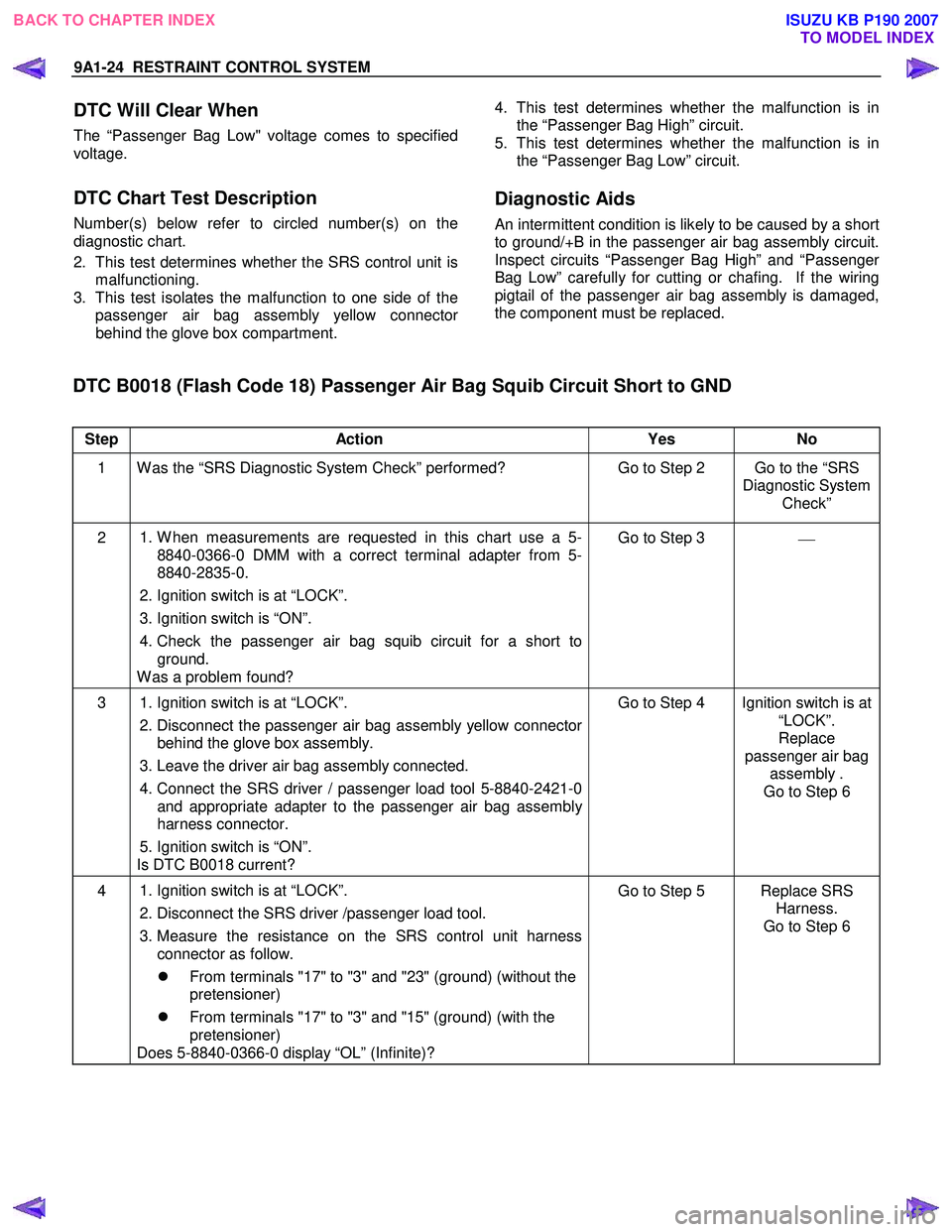
9A1-24 RESTRAINT CONTROL SYSTEM
DTC Will Clear When
The “Passenger Bag Low" voltage comes to specified
voltage.
DTC Chart Test Description
Number(s) below refer to circled number(s) on the
diagnostic chart.
2. This test determines whether the SRS control unit is malfunctioning.
3. This test isolates the malfunction to one side of the passenger air bag assembly yellow connecto
r
behind the glove box compartment.
4. This test determines whether the malfunction is in
the “Passenger Bag High” circuit.
5. This test determines whether the malfunction is in the “Passenger Bag Low” circuit.
Diagnostic Aids
An intermittent condition is likely to be caused by a short
to ground/+B in the passenger air bag assembly circuit.
Inspect circuits “Passenger Bag High” and “Passenge
r
Bag Low” carefully for cutting or chafing. If the wiring
pigtail of the passenger air bag assembly is damaged,
the component must be replaced.
DTC B0018 (Flash Code 18) Passenger Air Bag Squib Circuit Short to GND
Step Action Yes No
1 W as the “SRS Diagnostic System Check” performed?
Go to Step 2 Go to the “SRS
Diagnostic System Check”
2 1. W hen measurements are requested in this chart use a 5-
8840-0366-0 DMM with a correct terminal adapter from 5-
8840-2835-0.
2. Ignition switch is at “LOCK”.
3. Ignition switch is “ON”.
4. Check the passenger air bag squib circuit for a short to ground.
W as a problem found? Go to Step 3
3 1. Ignition switch is at “LOCK”.
2. Disconnect the passenger air bag assembly yellow connector behind the glove box assembly.
3. Leave the driver air bag assembly connected.
4. Connect the SRS driver / passenger load tool 5-8840-2421-0 and appropriate adapter to the passenger air bag assembly
harness connector.
5. Ignition switch is “ON”.
Is DTC B0018 current? Go to Step 4 Ignition switch is at
“LOCK”.
Replace
passenger air bag assembly .
Go to Step 6
4 1. Ignition switch is at “LOCK”.
2. Disconnect the SRS driver /passenger load tool.
3. Measure the resistance on the SRS control unit harness connector as follow.
�z From terminals "17" to "3" and "23" (ground) (without the
pretensioner)
�z From terminals "17" to "3" and "15" (ground) (with the
pretensioner)
Does 5-8840-0366-0 display “OL” (Infinite)? Go to Step 5 Replace SRS
Harness.
Go to Step 6
BACK TO CHAPTER INDEX TO MODEL INDEX
ISUZU KB P190 2007
Page 5709 of 6020

RESTRAINT CONTROL SYSTEM 9A1-27
DTC Will Clear When
The SRS control unit is replaced and the “Passenger
Bag Low" voltage comes to specified voltage.
DTC Chart Test Description
Number(s) below refer to circled number(s) on the
diagnostic chart.
2. This test determines whether the SRS control unit is malfunctioning.
3. This test isolates the malfunction to one side of the passenger air bag assembly yellow connecto
r
behind the glove box compartment.
4. This test determines whether the malfunction is in the “Passenger Bag High” circuit.
5. This test determines whether the malfunction is in the “Passenger Bag Low” circuit.
Diagnostic Aids
An intermittent condition is likely to be caused by a short
to ground/+B in the passenger air bag assembly circuit.
Inspect circuits “Passenger Bag High” and “Passenge
r
Bag Low” carefully for cutting or chafing. If the wiring
pigtail of the passenger air bag assembly is damaged,
the component must be replaced.
DTC B0019 (Flash Code 19) Passenger Air Bag Squib Circuit Short to Battery Voltage
Step Action Yes No
1 W as the “SRS Diagnostic System Check” performed? Go to Step 2 Go to the “SRS
Diagnostic System Check”
2 1. W hen measurements are requested in this chart use a 5-
8840-0366-0 DMM with a correct terminal adapter from 5-
8840-2835-0.
2. Ignition switch is at “LOCK”.
3. Ignition switch is “ON”.
4. Check the passenger air bag squib circuit for a short to voltage, short to ground and open.
W as a problem found? Go to Step 3
―
3 1. Ignition switch is at “LOCK”.
2. Disconnect the passenger air bag assembly yellow connector behind the glove box assembly.
3. Leave the driver air bag assembly connected.
4. Connect the SRS driver /passenger load tool 5-8840-2421-0 and appropriate adapter to the passenger air bag assembly
harness connector.
5. Ignition switch is “ON”.
Is DTC B0019 current? Go to Step 4 Ignition switch is at
“LOCK”.
Replace
passenger air bag assembly
Go to Step 6
4 Measure the resistance on the SRS control unit harness connector from terminal “17” to terminal “1” (ignition).
Does 5-8840-0366-0 display “OL” (Infinite)? Go to Step 5 Replace SRS
Harness.
Go to Step 6
5 Measure the resistance on the SRS control unit harness connector from terminal “16” to terminal “1” (ignition).
Does 5-8840-0366-0 display “OL” (Infinite)? Go to Chart A Replace SRS
Harness.
Go to Step 6
6 1. Reconnect all the components and ensure all components
are properly mounted.
2. Clear diagnostic trouble codes.
Is this step finished? Go to the “SRS
Diagnostic system Check” ―
BACK TO CHAPTER INDEX
TO MODEL INDEX
ISUZU KB P190 2007